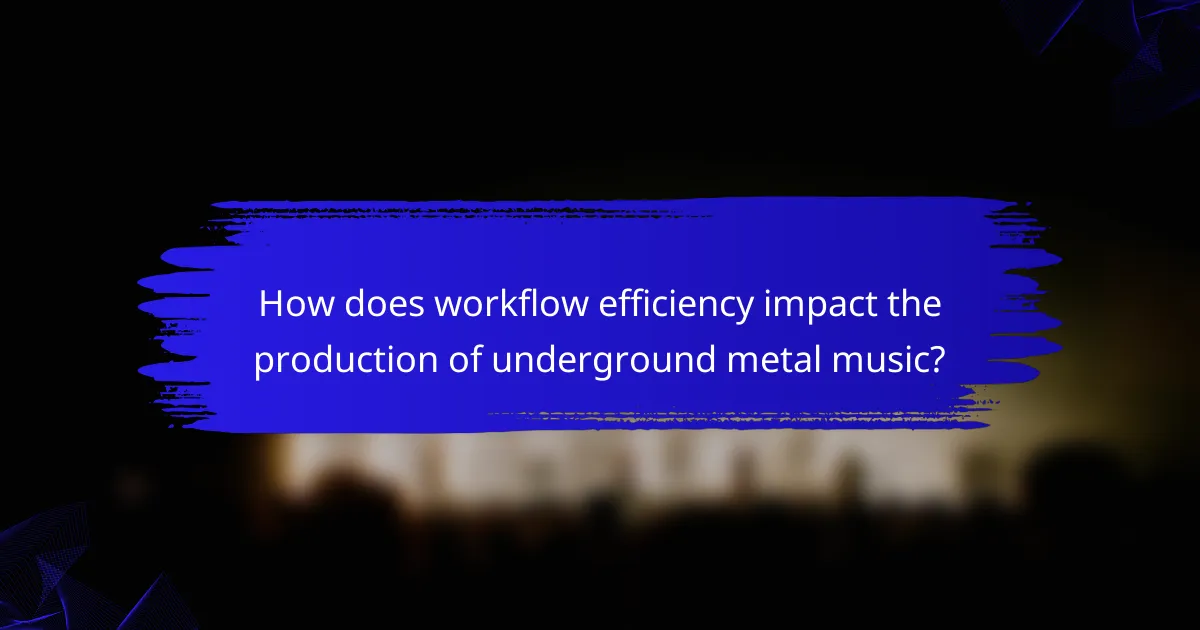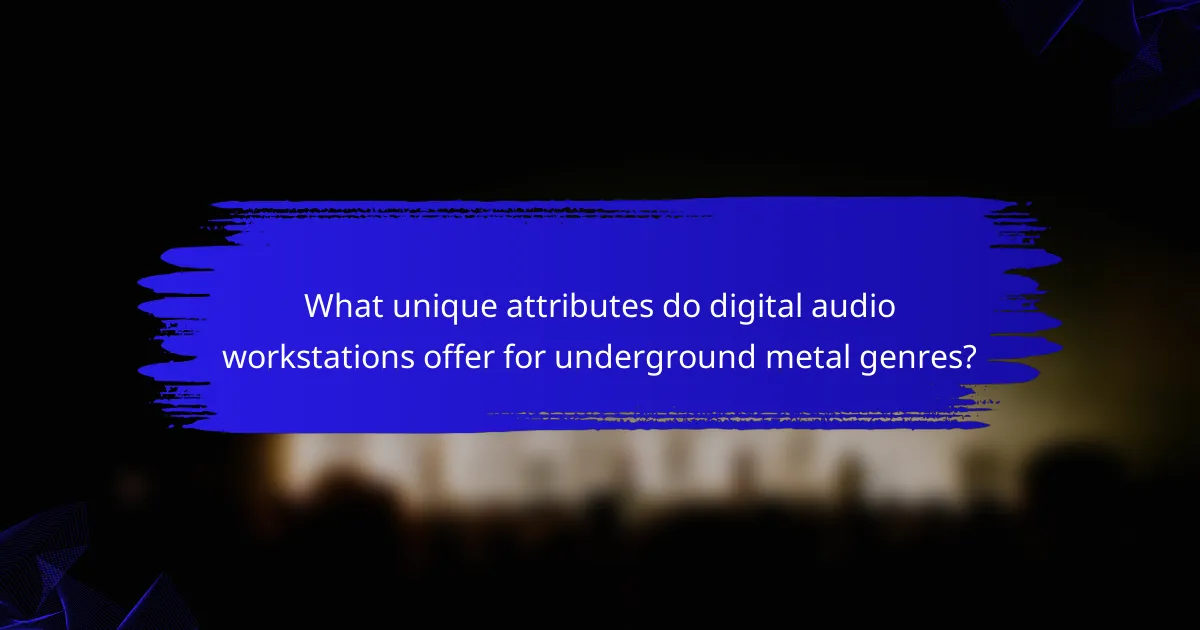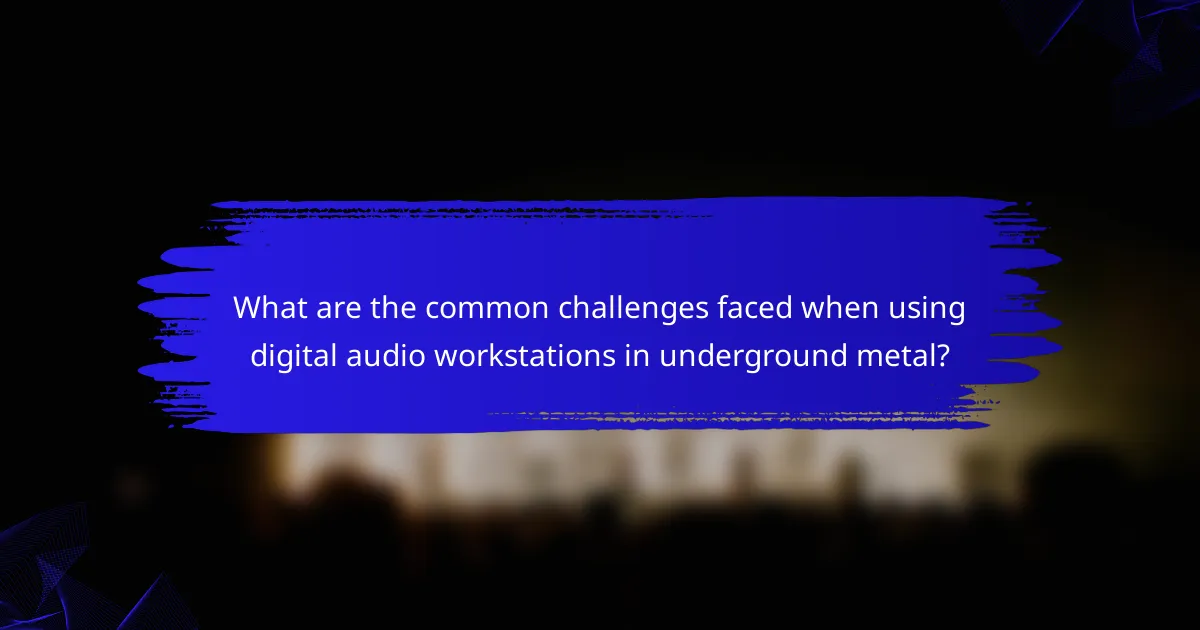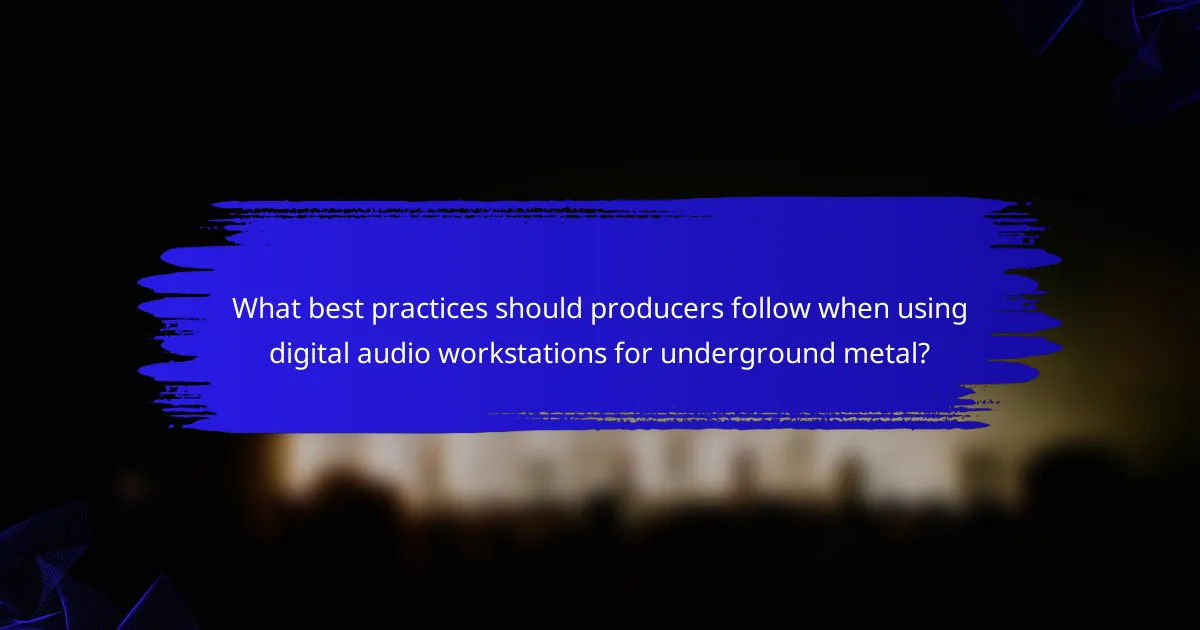Choosing the right digital audio workstation (DAW) is crucial for producing high-quality underground metal music. Key features include flexibility, robust editing tools, and extensive plugin support. Workflow efficiency enhances collaboration and sound design, while regional preferences influence DAW selection. Understanding these aspects can empower artists to maximize creativity and output in their music production.

What are the essential features of digital audio workstations for underground metal?
Digital audio workstations for underground metal must prioritize flexibility, audio quality, and user-friendly interfaces. Essential features include multiple audio tracks for complex arrangements, robust editing tools for precise sound design, and extensive plugin support for unique effects.
High-quality audio engines are crucial for achieving the desired sound fidelity. Low latency performance enhances real-time recording and playback, essential for capturing the intensity of underground metal. Customizable layouts allow musicians to tailor their workspace to fit their workflow, optimizing productivity.
Collaboration features enable artists to share projects seamlessly, fostering creativity and innovation within the underground metal community. Additionally, compatibility with various hardware, such as MIDI controllers and audio interfaces, ensures a versatile setup for diverse recording environments.
How do these features enhance music production?
Digital Audio Workstations enhance music production for underground metal by providing essential features like advanced audio editing, flexible routing, and powerful effects processing. These capabilities allow producers to manipulate sound creatively and achieve a polished final product. The unique attribute of real-time collaboration enables musicians to work together seamlessly, regardless of location. Additionally, built-in virtual instruments and extensive plugin support offer a wide range of sounds, catering to the diverse styles within underground metal. As a result, these features streamline the production process and elevate the overall quality of the music.
Which DAWs are most popular among underground metal producers?
The most popular DAWs among underground metal producers include Reaper, FL Studio, and Ableton Live. Reaper is favored for its flexibility and affordability, while FL Studio offers a user-friendly interface and powerful MIDI capabilities. Ableton Live is known for its real-time performance features, making it ideal for live shows. These DAWs support various plugins and sound libraries tailored for heavy genres, enhancing production quality.

How does workflow efficiency impact the production of underground metal music?
Workflow efficiency significantly enhances the production of underground metal music by streamlining the creative process. Digital Audio Workstations (DAWs) offer features that facilitate collaboration, editing, and sound design, which are crucial for this genre. Efficient workflows allow artists to focus on creativity rather than technical challenges.
DAWs provide unique attributes such as customizable interfaces, real-time collaboration tools, and extensive plugin support. These features enable musicians to experiment with sounds and arrangements without interruption. As a result, artists can produce high-quality tracks more quickly, fostering innovation in underground metal.
Moreover, efficient workflows reduce the time spent on repetitive tasks. For instance, batch processing and automation features in DAWs minimize manual input, allowing musicians to dedicate more time to refining their sound. This efficiency is essential in a genre that thrives on experimentation and unique sonic identities.
In conclusion, the impact of workflow efficiency on underground metal production is profound. Enhanced DAW features empower artists to maximize their creativity and output, ultimately shaping the evolution of the genre.
What specific tools improve workflow in digital audio workstations?
Digital audio workstations (DAWs) improve workflow with specific tools like MIDI editors, audio effects plugins, and automation features. These tools enhance creativity and streamline the production process.
Key tools include:
1. MIDI Editors: Allow precise control over musical notes and arrangements.
2. Audio Effects Plugins: Provide various sound manipulations, enhancing audio quality.
3. Automation Features: Enable dynamic changes in volume, panning, and effects throughout a track.
4. Collaboration Tools: Facilitate real-time sharing and editing among musicians.
5. Template Systems: Save time by using pre-configured settings for specific genres or projects.
Using these tools effectively can significantly boost productivity in underground metal music production.
How can producers optimize their setup for better efficiency?
Producers can optimize their setup for better efficiency by leveraging Digital Audio Workstations (DAWs) tailored for underground metal. Key practices include utilizing templates to streamline workflows, employing high-quality plugins for sound design, and organizing tracks for easy navigation.
1. Use templates to standardize sessions, reducing setup time.
2. Invest in reliable plugins to enhance audio quality and creativity.
3. Organize tracks by instrument type and arrangement for quick access.
4. Implement shortcuts and macros to speed up repetitive tasks.
These strategies enhance productivity and allow producers to focus on creativity.

What unique attributes do digital audio workstations offer for underground metal genres?
Digital audio workstations (DAWs) for underground metal genres offer unique attributes that enhance creativity and production quality. These include advanced distortion effects, custom routing options, and extensive MIDI capabilities tailored for complex compositions.
DAWs provide specialized plugins designed for heavy guitar tones, allowing for nuanced sound manipulation. They also support high track counts, accommodating dense arrangements typical in underground metal. Unique features like integrated drum programming tools enable artists to create intricate rhythms that define the genre.
Additionally, many DAWs facilitate collaboration through cloud-based sharing, enhancing community engagement among underground metal musicians. These unique attributes collectively empower artists to produce distinctive and high-quality music that resonates with their audience.
How do specialized plugins cater to the sound of underground metal?
Specialized plugins enhance the sound of underground metal by offering tailored effects, unique instrument emulations, and customizable mixing options. These plugins provide distortion, reverb, and modulation settings that cater specifically to the genre’s heavy and aggressive sound. For instance, plugins like Neural DSP and AmpliTube allow musicians to achieve authentic tones reminiscent of iconic underground metal bands. Additionally, many plugins offer flexibility in routing and signal processing, enabling a distinctive sonic identity. This customization is essential for creating the raw energy and complexity characteristic of underground metal music.
Which DAWs provide the best support for live recording sessions?
Pro Tools, Ableton Live, and Logic Pro X provide excellent support for live recording sessions. Pro Tools excels in audio editing and mixing capabilities, making it ideal for complex projects. Ableton Live offers real-time performance features, perfect for spontaneous creativity. Logic Pro X combines user-friendly interfaces with powerful recording tools, suitable for various music genres.

What are the common challenges faced when using digital audio workstations in underground metal?
Common challenges include software complexity, hardware limitations, and sound quality issues. Users often face a steep learning curve when navigating features. Additionally, compatibility problems with plugins can hinder workflow. Finally, achieving the desired sound in a genre-specific context can be difficult, requiring extensive experimentation and adjustments.
How can sound quality issues be resolved during production?
To resolve sound quality issues during production, utilize proper audio interfaces, monitor settings, and DAW plugins. Ensure high-quality recordings by using suitable microphones and maintaining optimal gain levels. Regularly check for latency and adjust buffer sizes in the DAW. Implement EQ and compression techniques to enhance audio clarity.
What are the limitations of popular DAWs in this genre?
Popular DAWs for underground metal have limitations that affect sound design and workflow. Many DAWs lack specialized features for heavy distortion and complex layering, which are crucial in this genre. Additionally, some DAWs may not support extensive plugin compatibility, limiting creative options. User interfaces can be less intuitive for metal-specific arrangements, leading to inefficient workflows. Finally, performance issues may arise when handling high track counts or demanding effects, which are common in metal production.

How do regional preferences influence the choice of digital audio workstations?
Regional preferences significantly shape the selection of digital audio workstations for underground metal. Users often prioritize features that align with their local music culture and genre-specific needs.
For example, certain regions may favor DAWs with strong support for heavy guitar effects, while others might emphasize collaboration tools for remote band members. Additionally, the availability of local plugins and sound libraries can influence choices.
User communities in various regions often share best practices, which can lead to the popularity of specific DAWs that cater to those shared preferences. As a result, the choice of a digital audio workstation is not only a matter of personal preference but also a reflection of regional musical trends and practices.
What cultural factors affect the production techniques in different areas?
Cultural factors significantly influence production techniques in underground metal across different regions. Local music traditions, available technology, and community values shape the sound and recording methods. For example, regions with a rich history of heavy music may prioritize raw sound, while others might emphasize polished production. Additionally, cultural attitudes towards music ownership and sharing can affect how artists approach recording and distribution.
How do local music scenes shape the use of technology in underground metal?
Local music scenes significantly influence how underground metal artists utilize technology, especially in Digital Audio Workstations (DAWs). These platforms enable musicians to experiment creatively while producing high-quality sound.
Key features of DAWs for underground metal include multi-track recording, audio editing capabilities, and a variety of effects plugins. Best practices involve leveraging these tools to achieve a polished sound that reflects the unique style of the local scene.
Collaboration is essential; artists often share projects and techniques, fostering innovation. Additionally, local influences shape sound design choices, making technology a vital component of the genre’s evolution.
As a result, underground metal continues to thrive through a blend of traditional musicianship and modern technology, enhancing both production quality and artistic expression.

What best practices should producers follow when using digital audio workstations for underground metal?
Producers should prioritize flexibility, sound quality, and workflow efficiency when using digital audio workstations for underground metal. Key practices include selecting DAWs that support high track counts and provide robust plugins for distortion and effects. Utilize templates tailored for metal genres to streamline sessions. Regularly save projects and back up data to avoid loss. Experiment with mixing techniques to achieve the desired heaviness and clarity in sound. Collaborate with other musicians to gain fresh perspectives on arrangements and production techniques.
What common mistakes should be avoided during production?
Avoiding common mistakes during production in digital audio workstations for underground metal is crucial for achieving high-quality sound. Key mistakes include neglecting proper gain staging, which can lead to distortion, and failing to utilize appropriate plugins that enhance the metal genre’s aggressive sound. Additionally, overlooking the importance of monitoring levels can result in an imbalanced mix. Lastly, not taking advantage of automation features may hinder dynamic expression in tracks.
How can collaboration tools enhance the creative process in underground metal?
Collaboration tools significantly enhance the creative process in underground metal by streamlining communication and enabling real-time feedback. These tools facilitate seamless sharing of ideas and resources, allowing musicians to collaborate from different locations. Features such as version control and integrated project management keep creative efforts organized and focused. Best practices include utilizing cloud-based platforms for easy access, setting clear goals for collaboration, and encouraging open communication to foster creativity and innovation.
What expert tips can improve the overall sound quality in productions?
To improve overall sound quality in productions, focus on optimizing your Digital Audio Workstation (DAW) settings and workflow. Use high-quality audio interfaces to capture sound accurately. Implement proper gain staging to prevent distortion. Utilize EQ to carve out space for different instruments, enhancing clarity. Experiment with reverb and compression to add depth and polish. Regularly update your plugins and software for the best performance.